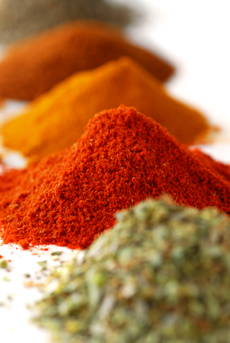
 The right spices are more than flavorful, fragrant and colorful: They have antioxidant properties, too. Photo by Elena Elisseeva | IST.
July 2008
|
 |
Antioxidant Spices
Seven Super Spices That Help Fight Cancer, Illness And Aging
CAPSULE REPORT: It’s long been accepted that a diet high in fruits and vegetables helps prevent cancer and stave off age-related illnesses such as Alzheimer’s, diabetes and heart disease. But what some people may not know is that it’s the antioxidants present in fruits and vegetables that are imparting all these health benefits. There are plenty of other antioxidant-rich foods out there, too—some you’ve probably never even considered. Many spices, for example, actually carry more antioxidants than the produce with which we’re already so familiar. Spice giant McCormick has compiled a list of seven “Super Spices” that posses some of the highest antioxidant power you can get, as well as recipes in which to enjoy each one.
This is Part I of an eight-part article. Use the index immediately below to navigate from page to page.
What Is An Antioxidant?
An antioxidant is an enzyme or other organic molecule that reduces the rate of particular oxidation reactions and can counteract the damaging effects of oxidation, which can produce “free radicals.”
Free radicals are highly unstable and reactive molecules that attack, infiltrate and injure vital cell structures. They are constantly formed as a natural by-product of body chemistry. Free radicals are highly toxic and can damage important cellular molecules such as DNA, lipids or other parts of the cell, impairing the brain and other tissue. They are believed to accelerate the progression of age-related conditions and other diseases.
Antioxidants are measured in “ORAC,” or “oxygen radical absorbance capacity,” a test tube analysis that quantifies the total antioxidant power of foods. When comparing the ORAC value of different foods, however, serving size must be considered. A 2007 ORAC chart compiled by the Beltsville Human Nutrition Research Center (BHNRC), Agricultural Research Service (ARS) and the U.S. Department of Agriculture (USDA) compares 100-gram doses of each food. But 100 grams amounts to over 20 teaspoons, or less than half a cup, which is hardly a fair comparison. You might eat half a cup of cherries, for example, in one sitting, but you’d never consume 20 teaspoons of cinnamon all at once.
The Super Spices
Although fruits and vegetables are the classic example of antioxidant-rich foods, it can be difficult to get in all five recommended servings every day. Not everyone has access to fresh, quality produce, for one thing. And if you eat on the run, finding a piece of fruit at all can be near impossible.
There is hope, though! Spices are one way to to add both flavor and a shot of antioxidants in one go. In fact, some spices actually contain more antioxidants per serving than some fruits and vegetables. One teaspoon of cinnamon, for example, contains over twice as much ORAC as half a cup of raspberries, another antioxidant-rich choice.
In fact, of all the antioxidant-rich spices that exist, seven of the most powerful ones are choices you probably use every day! The Seven Super Spices (so christened by spice manufacturer McCormick) include cinnamon, ginger, oregano, red pepper (including chile powder, crushed red pepper flakes and paprika), rosemary, thyme and yellow curry. Even better, all of these are easy to implement into your regular eating habits: Try cinnamon on your breakfast cereal, oregano and red pepper on lunchtime soup or pizza, and rosemary makes dinnertime mashed or roasted potatoes that much better. Or you can start from scratch and follow one of the recipes provided here. See our ORAC comparison chart below, then check out each spice’s page for more information and recipes.
| Spice |
Serving Size |
ORAC Units |
| Cinnamon |
1 tsp |
6956 |
| Ginger |
1 tsp |
519 |
| Oregano |
1 tsp |
3602 |
| Red Chile Pepper |
1 tsp |
376-615 |
| Rosemary |
1 tsp |
364 |
| Thyme |
1 tsp |
407 |
| Yellow Curry |
1 tsp |
970 |
Go To Part II: Cinnamon
Go To The Index At The Top Of The Page
All material

|